I have implemented basic Hardware model instancing method in XNA code by following this short tutorial: http://www.float4x4.net/index.php/2011/07/hardware-instancing-for-pc-in-xna-4-with-textures/
I have created the needed shader (without texture atlas though, single texture only) and I am trying to use this method to draw a simple tree I generated using 3DS Max 2013 and exported via FBX format.
The results I'm seeing left me without clue as to what is going on.

Back when I was using no instancing methods, but simply calling Draw on a mesh (for every tree on a level), the whole tree was shown:

I have made absolutely sure that the Model contains only one Mesh and that Mesh contains only one MeshPart.
I am using Vertex Extraction method, by using Model's Vertex and Index Buffer "GetData<>()" method, and correct number of vertices and indices, hence, correct number of primitives is rendered. Correct texture coordinates and Normals for lighting are also extracted, as is visible by the part of the tree that is being rendered.
Also the parts of the tree are also in their correct places as well.
They are simply missing some 1000 or so polygons for absolutely no reason what so ever. I have break-pointed at every step of vertex extraction and shader's parameter generation, and I cannot for the life of me figure out what am I doing wrong.
My Shader's Vertex Transformation function:
VertexShaderOutput VertexShaderFunction2(VertexShaderInput IN, float4x4 instanceTransform : TEXCOORD1)
{
VertexShaderOutput output;
float4 worldPosition = mul(IN.Position, transpose(instanceTransform));
float4 viewPosition = mul(worldPosition, View);
output.Position = mul(viewPosition, Projection);
output.texCoord = IN.texCoord;
output.Normal = IN.Normal;
return output;
}
Vertex bindings and index buffer generation:
instanceBuffer = new VertexBuffer(Game1.graphics.GraphicsDevice, Core.VertexData.InstanceVertex.vertexDeclaration, counter, BufferUsage.WriteOnly);
instanceVertices = new Core.VertexData.InstanceVertex[counter];
for (int i = 0; i < counter; i++)
{
instanceVertices[i] = new Core.VertexData.InstanceVertex(locations[i]);
}
instanceBuffer.SetData(instanceVertices);
bufferBinding[0] = new VertexBufferBinding(vBuffer, 0, 0);
bufferBinding[1] = new VertexBufferBinding(instanceBuffer, 0, 1);
Vertex extraction method used to get all vertex info (this part I'm sure works correctly as I have used it before to load test geometric shapes into levels, like boxes, spheres, etc for testing various shaders, and constructing bounding boxes around them using extracted vertex data, and it is all correct):
public void getVertexData(ModelMeshPart part)
{
modelVertices = new VertexPositionNormalTexture[part.NumVertices];
rawData = new Vector3[modelVertices.Length];
modelIndices32 = new uint[rawData.Length];
modelIndices16 = new ushort[rawData.Length];
int stride = part.VertexBuffer.VertexDeclaration.VertexStride;
VertexPositionNormalTexture[] vertexData = new VertexPositionNormalTexture[part.NumVertices];
part.VertexBuffer.GetData(part.VertexOffset * stride, vertexData, 0, part.NumVertices, stride);
if (part.IndexBuffer.IndexElementSize == IndexElementSize.ThirtyTwoBits)
part.IndexBuffer.GetData<uint>(modelIndices32);
if (part.IndexBuffer.IndexElementSize == IndexElementSize.SixteenBits)
part.IndexBuffer.GetData<ushort>(modelIndices16);
for (int i = 0; i < modelVertices.Length; i++)
{
rawData[i] = vertexData[i].Position;
modelVertices[i].Position = rawData[i];
modelVertices[i].TextureCoordinate = vertexData[i].TextureCoordinate;
modelVertices[i].Normal = vertexData[i].Normal;
counter++;
}
}
This is the rendering code for the object batch (trees in this particular case):
public void RenderHW()
{
Game1.graphics.GraphicsDevice.RasterizerState = rState;
treeBatchShader.CurrentTechnique.Passes[0].Apply();
Game1.graphics.GraphicsDevice.SetVertexBuffers(bufferBinding);
Game1.graphics.GraphicsDevice.Indices = iBuffer;
Game1.graphics.GraphicsDevice.DrawInstancedPrimitives(PrimitiveType.TriangleList, 0, 0, treeMesh.Length, 0, primitive , counter);
Game1.graphics.GraphicsDevice.RasterizerState = rState2;
}
If anybody has any idea where to even start looking for errors, just post all ideas that come to mind, as I'm completely stumped as to what's going on.
This even counters all my previous experience where I'd mess something up in shader code or vertex generation, you'd get some absolute mess on your screen - numerous graphical artifacts such as elongated triangles originating where mesh should be, but one tip stretching back to (0,0,0), black texture, incorrect positioning (often outside skybox or below terrain), incorrect scaling...
This is something different, almost as if it works - the part of the tree that is visible is correct in every single aspect (location, rotation, scale, texture, shading), except that a part is missing. What makes it weirder for me is that the part missing is seemingly logically segmented: Only tree trunk's primitives, and some leaves off the lowest branches of the tree are missing, leaving all other primitives correctly rendered with no artifacts. Basically, they're... correctly missing.